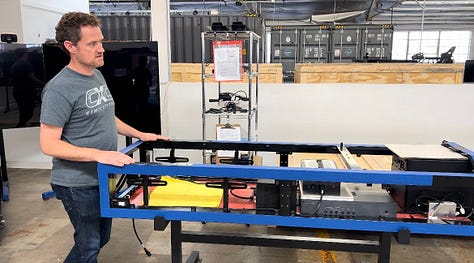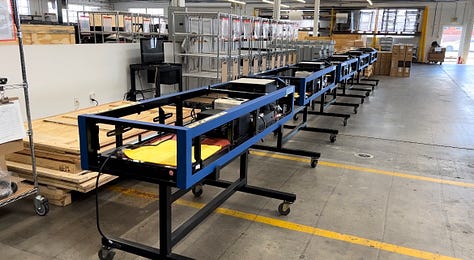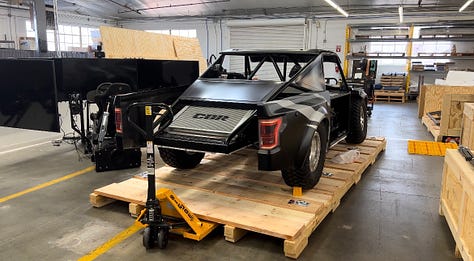Happy Race Day! especially to… YOU. Thank you, so much, to everyone who has made this ride possible. Race Day started this week in 2019 which is pretty hard to believe. It’s been through a lot, which I’ll detail below. But first let me just say, thank you.
Race Day started as a way to document changes in car culture, week to week. It was really happening that fast. The way we drove, talked and thought about cars was in total flux. It was fun, fresh and exciting.
I hoped people could come here and find that reflected in my writing. Change is scary, but to me, this particular change has been full of wonder. I wanted to make people feel it was okay to enjoy the ride. And admit they were having fun.
And making Race Day gave me an outlet to promote my book, Slow Car Fast, and spread its ideas in a sort-of running addendum. Through Covid it helped me discover sim racing. Over time it documented the return of motorsports and car meets.
Through it all there was my passion for cars. And there was my dedication for covering the culture in the way I felt it deserved. And there was you. When it was hard, those things kept me going, and convinced me to start again.
Race Day has always been about people. And I can look back on the past four years and say the people made it special. The subjects, the creators and the readers. I wanted to shine a light, and I’ve had a lot of fun doing it. Here’s to four more.
Now, onto our lead article…
Inside CXC — the Sim Racing Standard-Bearer
Word about my GT-R book is getting around. Recently I mentioned it to a friend, and a few calls later we had a visit to CXC Simulations arranged. The deal was I’d drive every GT-R generation on their gaming system. But it was so much more than that.
As you can see in my latest YouTube video above, these rigs are no regular arcade game. CXC makes sophisticated, high-powered motion seats. Professional racecar drivers use them to train. Slide into the bucket seat and you had better buckle up.
I drove their latest Motion Pro II simulator with the optional Competition seat and panoramic 77-inch 4K Ultra HD screens. It’s a serious machine. A new one starts at $69,000. The one I used was priced from at least $89,900.
“I like to think that we started this market,” said Chris Considine, founder and CEO of CXC. The company has now delivered rigs to every continent except Antarctica and has a partnership to install systems on Norwegian Cruise Lines ships.
This is as real as it gets, and CXC customers pay accordingly. But the payoff is the closest simulator you can get to the real thing, making almost unlimited training possible (without travel, shipping a car, renting a track and risking crash or injury).
So how did it feel? Here’s what struck me about each car:
1970 Hakosuka GT-R 2-Door: The realism was stunning. I could feel each crack and bump in the road and identify which tire hit it. Very fun car to toss around.
1972 Kenmeri GT-R: By comparison, a total boat. Big, exaggerated movements that made fast turns really fun. The soft suspension felt almost like surfing.
1989 R32 GT-R: What a drastic change from ‘72-89. This was very composed and agile at speed. I could feel the 4WD system pulling the rear around.
1995 R33 GT-R: The stability was impressive. Little bumps and cracks reverberate differently than in the older models. The sensation of speed! Wow.
1999 R34 GT-R: Funny thing here — more than the others, when I messed up I could feel the loss of control. Front gets light. Rear gets wiggly. Weird!
1999 JGTC Pennzoil Nismo R34 GT-R: Onto the racecars. The G-forces were immediately apparent, swinging side to side. Like riding piggyback on a jaguar.
2014 GT500 R35 GT-R: Total time attack machine. Like the Pennzoil, but tighter handling and bigger G’s. Incredible fun and I barely scratched its potential.
It was amazing to feel all of the differences, both major and minor, between the GT-R generations. Even though the ‘89-99 cars use similar chassis with relatively small adjustments they felt totally different through the seat.
This is the granularity that makes a difference to pro drivers, and convinces their teams that a nearly-$90,000 gaming system is a good investment. And it’s working. CXC has a 3-4 month waiting list at the moment.
When I visit, Considine shows me the Special Projects lab, filled with laser-cutters and 3D printers and CNC machines for fabricating custom parts. They can customize anything the customer wants. Twenty percent of all CXC orders go through here.
“Everything they do has got to be rapid,” Considine said. Demanding customers with exacting standards aren’t used to being told to wait. “They’re not just wealthy and into cars — they also take it very seriously.”



CXC sits atop the sim racing market. During lockdown, esports and home simulators exploded, and Drive to Survive on Netflix stirred up interest. CXC quickly sold all pre-owned models in stock. “They just like, evaporated,” Considine said.
Since then sales have steadied, but demand is still strong. He shows me the production line, full of rig structures waiting to be fitted with seats, wheels, pedals and screens. High-powered computers are installed under the floor.
In recent years Considine has seen major tech advancements make a big difference. “It’s never good enough,” he said. New haptic systems, refresh rates, processor speeds and the rise of VR have all changed the game. They’re getting closer to the real thing.
The popularity has even caught Considine off guard. “There was no grand plan for taking over the world with racing simulators,” he said. Maybe not, but you can now race any GT-R while sailing the world’s oceans. What could be more grand?
Culture
Really enjoyed this write-up about IndyCar’s new docu-series, 100 Days to Indy, by pit mechanic and Race Day friend Bozi Tatarevic. Will you be watching?
The IG account @GT1History is doing a series that mythbusts rumors about GT1 racecars from the 1990s (teenage Ryan’s favorite, btw). No. 1: Nissan-powered McLarens. No. 2: Mistaken Mercedes. No. 3: Toyota in Hiding.
Lucy Block, the widow of rally influencer Ken Block, is keeping his legacy alive — by rally racing, of course. These photos from her latest outing are good, dirty fun.
The annual GridLife Festival, a celebration of racing/music/camping all at once, returns to Michigan in a few weeks. If you haven’t seen one of these maniacal events, just take a look and soak in all the fun they’re having.
You may be cool, but are you as cool as this 4-year old driving stick in a racecar?
Video Reel
There’s no shortage of drifting games out there. But apparently there’s room for one more as Japanese Drift Master prepares to hit the PC. What separates this? Looks like an emphasis on tuning and unique driving style. Graphics are fire, though.
This is such a great series on all the ways car culture has changed in recent years. This installment focuses on YouTube, and specifically how it’s desensitized us. It really could be the topic of a master’s thesis.
There was a time when “Who is the Stig?” was the hottest question in the entire automotive universe. To hear him speak openly about it now is really fun.
And Finally…
Kristen Lee, editor at Motor Trend, is honoring Asian American and Pacific Islander Heritage Month by profiling people of AAPI descent in car culture. Her first dispatch is about racecar driver Samantha Tan. Her second is on automotive personality RJ de Vera. Happy AAPI Heritage Month!
Drive hard and be safe. Black Lives Matter.
Race Day has subscribers in 33 states and 16 countries! Want your event included? Shoot me a note with subject line “Race Day” at ryan@carrarabooks.com.
Check out Carrara Media on Instagram, Twitter and Facebook and visit our store to order one of our many fine books and eBooks.





